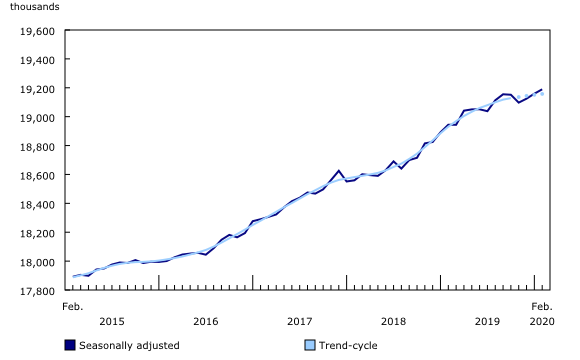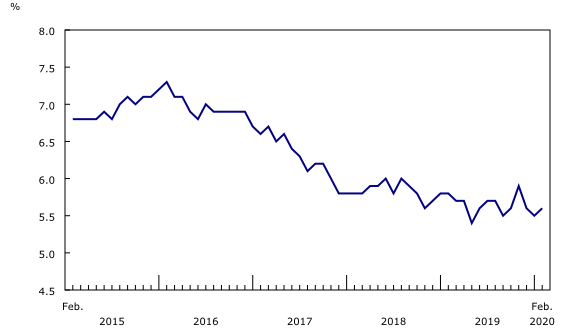Labour Force Survey, February 2020
Archived Content
Information identified as archived is provided for reference, research or recordkeeping purposes. It is not subject to the Government of Canada Web Standards and has not been altered or updated since it was archived. Please "contact us" to request a format other than those available.
Released: 2020-03-06
Employment was little changed in February (+30,000 or +0.2%), and the unemployment rate increased by 0.1 percentage points to 5.6%.
Compared with 12 months earlier, employment rose by 245,000 (+1.3%), the result of gains in full-time work (+252,000 or +1.6%). Over the same period, hours worked were up 2.3%, partly due to the fact that hours worked were at a relatively low level in February 2019.
To explore the most recent results from the Labour Force Survey in an interactive format, visit the "Labour Force Survey in brief: Interactive app."
Highlights
While there was little overall employment change in February, there were increases in Quebec, Alberta, Nova Scotia and Manitoba. Little change was observed in the remaining provinces.
Employment increased for youth, while there was little change among the core-aged and older populations.
In February, there were more people working in wholesale and retail trade, in manufacturing, as well as in information, culture and recreation. At the same time, employment declined in professional, scientific and technical services and in accommodation and food services.
There was little change in the number of employees in both the private and public sectors. Self-employment held steady.
Notable employment gains in Quebec
Employment in Quebec increased for a third consecutive month, up by 20,000 in February. The unemployment rate fell 0.6 percentage points to 4.5%, the lowest rate in the province since comparable data became available in 1976. Most of the employment gains in February were among youth aged 15 to 24. Their unemployment rate declined by 1.9 percentage points to 6.8%, also the lowest rate since 1976. Compared with February 2019, total employment in Quebec rose by 66,000 (+1.5%).
In Alberta, employment increased by 11,000, mostly among youth. The unemployment rate was little changed at 7.2%. On a year-over-year basis, employment in the province was virtually unchanged.
Employment in Nova Scotia rose by 3,700 in February. The unemployment rate increased 0.4 percentage points to 7.8% as more people looked for work. Compared with 12 months earlier, employment in the province was little changed.
In Manitoba 3,200 more people were employed in February, and the unemployment rate was virtually unchanged at 5.0%. Employment in the province has trended up since December, bringing year-over-year gains to 9,700 (+1.5%).
While employment held steady in British Columbia and Ontario in February, the unemployment rate rose notably as more people searched for work. The rate increased by 0.5 percentage points to 5.0% in British Columbia and by 0.3 percentage points to 5.5% in Ontario.
In New Brunswick, employment was unchanged, but the unemployment rate fell 0.6 percentage points to 6.9% as fewer people searched for work.
Youth employment increases
Employment for youth aged 15 to 24 increased by 22,000 in February, mostly among those aged 20 to 24. The overall youth unemployment rate was unchanged at 10.3%. Compared with 12 months earlier, youth employment rose by 54,000 (+2.2%).
For the population aged 25 to 54 (core-aged), employment held steady for a third consecutive month in February, and the unemployment rate was 4.7%. On a year-over-year basis, the number of people employed in this age group grew by 72,000 (+0.6%), while their population increased by 141,000 (+0.9%).
In February, employment for people aged 55 and older also held steady for a third consecutive month. Their unemployment rate increased by 0.4 percentage points to 5.1%, as more of them searched for work. Compared with 12 months earlier, employment in this age group rose by 119,000 (+2.9%), while their population increased by 298,000 (+2.6%), more than twice the population increase of the core-aged.
Industry overview
Employment in wholesale and retail trade rose by 23,000 in February, contributing to year-over-year gains of 57,000 (+2.0%).
The number of people working in manufacturing increased for a second consecutive month, up by 16,000 in February. Most of the gains were recorded in Ontario. Compared with 12 months earlier, national employment in the sector was unchanged.
In information, culture and recreation, employment grew by 14,000, bringing the number of people working in this sector to a level similar to that of 12 months earlier.
There were 15,000 fewer people working in professional, scientific and technical services in February, with all of the decline occurring in Ontario. On a year-over-year basis, employment in this industry was little changed.
In accommodation and food services, employment decreased by 13,000 in February and was little changed compared with 12 months earlier.
Employment in educational services was unchanged in February. An estimated 15% of employees (unadjusted for seasonality) working in this sector in Ontario lost hours during the survey reference week (February 9 to February 15) due to labour disputes. The majority were elementary and secondary school teachers and most of those who lost hours missed only part of the week.
Actual hours worked
In February, hours worked in British Columbia, Newfoundland and Labrador and Alberta rebounded following declines in January related to severe weather conditions. At the same time, hours worked increased in Quebec, Ontario, Manitoba and Nova Scotia. As a result, total hours worked nationally were up by 1.2% compared with January.
Total hours worked increased by 2.3% on a year-over-year basis, reflecting the notable monthly growth in February and the fact that hours were at a relatively low level in February 2019.
Sustainable Development Goals
On January 1, 2016, the world officially began implementation of the 2030 Agenda for Sustainable Development—the United Nations' transformative plan of action that addresses urgent global challenges over the next 15 years. The plan is based on 17 specific sustainable development goals.
The Labour Force Survey is an example of how Statistics Canada supports the reporting on the global sustainable development goals. This release will be used to help measure the following goals:


Note to readers
The Labour Force Survey (LFS) estimates for February are for the week of February 9 to 15.
The LFS estimates are based on a sample and are therefore subject to sampling variability. As a result, monthly estimates will show more variability than trends observed over longer time periods. For more information, see "Interpreting Monthly Changes in Employment from the Labour Force Survey."
Estimates for smaller geographic areas or industries also have more variability. For an explanation of the sampling variability of estimates and how to use standard errors to assess this variability, consult the "Data quality" section of the publication Labour Force Information (71-001-X).
This analysis focuses on differences between estimates that are statistically significant at the 68% confidence level.
The LFS estimates are the first in a series of labour market indicators released by Statistics Canada, which includes indicators from programs such as the Survey of Employment, Payrolls and Hours (SEPH); Employment Insurance Statistics; and the Job Vacancy and Wage Survey. For more information on the conceptual differences between employment measures from the LFS and those from the SEPH, refer to section 8 of the Guide to the Labour Force Survey (71-543-G).
LFS estimates at the Canada level do not include the territories.
The employment rate is the number of employed people as a percentage of the population aged 15 and older. The rate for a particular group (for example, youths aged 15 to 24) is the number employed in that group as a percentage of the population for that group.
The unemployment rate is the number of unemployed people as a percentage of the labour force (employed and unemployed).
The participation rate is the number of employed and unemployed people as a percentage of the population.
Full-time employment consists of persons who usually work 30 hours or more per week at their main or only job.
Part-time employment consists of persons who usually work less than 30 hours per week at their main or only job.
Total hours worked refers to the number of hours actually worked at the main job by the respondent during the reference week, including paid and unpaid hours. These hours reflect temporary decreases or increases in work hours (for example, hours lost due to illness, vacation, holidays or weather; or more hours worked due to overtime).
In general, month-to-month or year-to-year changes in the number of people employed in an age group reflect the net effect of two factors: (1) the number of people who changed employment status between reference periods, and (2) the number of employed people who entered or left the age group (including through aging, death or migration) between reference periods.
To update concepts related to duration of unemployment, seasonally adjusted data and standard errors have been added to table 14-10-0342-01, detailing duration of unemployment categories by sex and age group. Three new duration of unemployment categories (14 to 26 weeks, less than 27 weeks, 52 weeks or more) have been added to the table, replacing previous categories in archived table 14-10-0056-01. These new categories align with those used in the Employment Insurance program and provide better insight on duration of unemployment characteristics. Two new indicators (percentage unemployed less than 27 weeks, percentage unemployed 27 weeks or more) have also been added, as the latter can be used as an indicator of long-term unemployment.
Seasonal adjustment
Unless otherwise stated, this release presents seasonally adjusted estimates, which facilitate comparisons by removing the effects of seasonal variations. For more information on seasonal adjustment, see Seasonally adjusted data – Frequently asked questions.
Chart 1 shows trend-cycle data on employment. These data represent a smoothed version of the seasonally adjusted time series, which provides information on longer-term movements, including changes in direction underlying the series. These data are available for the national and provincial employment series in table 14-10-0287-01 and for national employment by industry in table 14-10-0355-01. For more information, see the StatCan Blog and Trend-cycle estimates – Frequently asked questions.
Next release
The next release of the LFS will be on April 9.
Products
Labour Force Information (71-001-X) is now available for the week ending February 15.
More information about the concepts and use of the Labour Force Survey is available online in the Guide to the Labour Force Survey (71-543-G).
The product "Labour Force Survey in brief: Interactive app" (14200001) is also available. This interactive visualization application provides seasonally adjusted estimates available by province, sex, age group and industry. Historical estimates going back five years are also included for monthly employment changes and unemployment rates. The interactive application allows users to quickly and easily explore and personalize the information presented. Combine multiple provinces, sexes and age groups to create your own labour market domains of interest.
The product "Labour Market Indicators, by province and census metropolitan area, seasonally adjusted" (71-607-X) is also available. This interactive dashboard provides easy, customizable access to key labour market indicators. Users can now configure an interactive map and chart showing labour force characteristics at the national, provincial or census metropolitan area level.
The product "Labour Market Indicators, by province, territory and economic region, unadjusted for seasonality" (71-607-X) is also available. This dynamic web application provides access to Statistics Canada's labour market indicators for Canada, by province, territory and economic region and allows users to view a snapshot of key labour market indicators, observe geographical rankings for each indicator using an interactive map and table, and easily copy data into other programs.
Contact information
For more information, contact us (toll-free 1-800-263-1136; 514-283-8300; STATCAN.infostats-infostats.STATCAN@canada.ca).
To enquire about the concepts, methods or data quality of this release, contact Vincent Ferrao (613-951-4750; vincent.ferrao@canada.ca) or Emmanuelle Bourbeau (613-951-3007; emmanuelle.bourbeau@canada.ca), Centre for Labour Market Information.
- Date modified:





